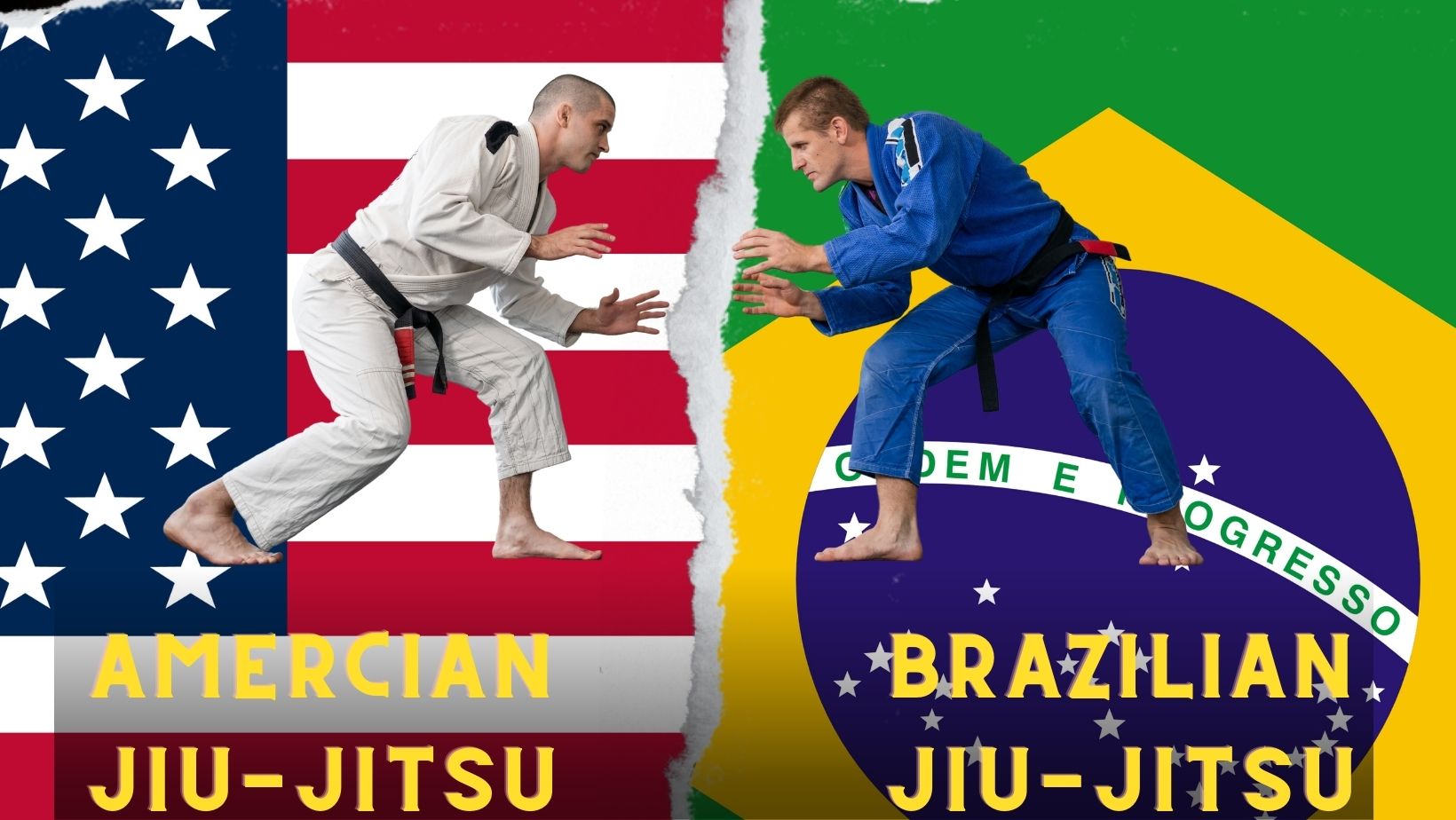American Jiu Jitsu vs Brazilian Jiu Jitsu – Which Grappling Style Reigns Supreme?
Table of Contents:
- Introduction
- Historical Origins of Brazilian Jiu Jitsu
- Emergence of American Jiu Jitsu
- Key Differences in Technique and Style
- Competitive Landscape: Comparing Achievements
- Cultural Influences and Community Dynamics
- Training Philosophies: Approach and Methodology
- Evolution and Innovation in Both Styles
- Conclusion: Embracing Diversity in Jiu Jitsu
Introduction:
In the vast and dynamic world of martial arts, few disciplines have garnered as much attention and reverence as Brazilian Jiu Jitsu (BJJ). However, in recent years, a new term has emerged: American Jiu Jitsu. This article aims to explore the nuances and distinctions between these two styles, delving into their historical origins, technical differences, competitive landscapes, cultural influences, and training philosophies. By understanding the similarities and differences between American Jiu Jitsu and Brazilian Jiu Jitsu, practitioners and enthusiasts can gain a deeper appreciation for the rich tapestry of techniques and approaches within the realm of Jiu Jitsu.
Historical Origins of Brazilian Jiu Jitsu:
Brazilian Jiu Jitsu traces its roots back to the early 20th century in Japan, where Judo, a martial art emphasizing throws and groundwork, was developed. Mitsuyo Maeda, a Judo master, traveled to Brazil, where he taught his art to Carlos Gracie. Carlos, along with his brothers, adapted and refined these techniques to create Brazilian Jiu Jitsu, focusing on leverage, technique, and ground fighting. Over time, BJJ evolved into a comprehensive grappling system, renowned for its effectiveness in real-life self-defense situations and competitive arenas. For those interested in deepening their understanding of Brazilian Jiu Jitsu, you can explore more details in this article Brazilian Jiu Jitsu.
Emergence of American Jiu Jitsu:
American Jiu Jitsu, on the other hand, is a relatively recent phenomenon that has gained momentum in the global martial arts community. While rooted in Brazilian Jiu Jitsu, American Jiu Jitsu incorporates elements of American wrestling, judo, and other grappling arts. This fusion of techniques reflects the diverse cultural landscape of the United States and the innovative spirit of American athletes. Notable figures like Eddie Bravo and Jake Shields have contributed to the development and popularization of American Jiu Jitsu, introducing unique approaches and strategies to the mat.
Key Differences in Technique and Style:
One of the primary distinctions between American Jiu Jitsu and Brazilian Jiu Jitsu lies in their technical approaches and stylistic preferences. Brazilian Jiu Jitsu emphasizes positional dominance, leverage, and submission holds, with practitioners often wearing traditional Gi uniforms. In contrast, American Jiu Jitsu incorporates more wrestling-based techniques, focusing on takedowns, control positions, and ground-and-pound strategies, particularly in No Gi settings. While both styles share common ground in ground fighting, their respective emphasis on technique versus aggression shapes their unique identities.
Competitive Landscape: Comparing Achievements:
The competitive landscape provides insight into the prowess and achievements of practitioners from both American Jiu Jitsu and Brazilian Jiu Jitsu backgrounds. Historically, Brazilian Jiu Jitsu has dominated international competitions, with Brazilian athletes like the Gracie family and modern-day champions such as Marcelo Garcia and Marcus Almeida (“Buchecha”) showcasing their skills on the world stage. However, American Jiu Jitsu has rapidly gained traction, producing formidable competitors like Gordon Ryan, Garry Tonon, and AJ Agazarm, who have achieved success in prestigious tournaments such as ADCC and EBI.
Cultural Influences and Community Dynamics:
Beyond technical prowess, cultural influences and community dynamics play a significant role in shaping the ethos of American Jiu Jitsu and Brazilian Jiu Jitsu. Brazilian Jiu Jitsu is deeply rooted in Brazilian culture, reflecting values of camaraderie, respect, and perseverance. Traditional Brazilian academies often emphasize lineage and hierarchy, with a strong sense of camaraderie among teammates. In contrast, American Jiu Jitsu reflects the melting pot of cultures in the United States, fostering an environment of innovation, experimentation, and individualism. This diversity of perspectives contributes to the evolution and adaptation of Jiu Jitsu techniques and strategies.
Training Philosophies: Approach and Methodology:
The training philosophies of American Jiu Jitsu and Brazilian Jiu Jitsu diverge in their approach and methodology, reflecting cultural differences and historical influences. Brazilian Jiu Jitsu academies typically follow a structured curriculum, emphasizing fundamental techniques, positional drilling, and live sparring sessions. The belt system, inherited from Judo, serves as a marker of progress and proficiency, with promotions awarded based on skill, knowledge, and character. In contrast, American Jiu Jitsu academies may adopt a more eclectic approach, incorporating elements of wrestling, judo, and MMA into their training regimens. This hybridization allows practitioners to develop well-rounded skill sets suited for both sportive and self-defense scenarios.
Evolution and Innovation in Both Styles:
Both American Jiu Jitsu and Brazilian Jiu Jitsu continue to evolve and innovate, driven by the quest for excellence and the demands of modern competition. Brazilian Jiu Jitsu practitioners explore new techniques, strategies, and training methodologies to gain a competitive edge, while American Jiu Jitsu enthusiasts experiment with wrestling-based tactics and unconventional submissions. The proliferation of instructional resources, online platforms, and cross-training opportunities has facilitated the exchange of ideas and techniques, leading to a rich tapestry of innovation within the global Jiu Jitsu community.
If you’re curious about the distinctions between different styles, this piece on Jiu Jitsu vs Brazilian Jiu Jitsu provides valuable insights. Additionally, to learn about the unique aspects of Gracie Jiu Jitsu compared to Brazilian Jiu Jitsu, check out Gracie Jiu Jitsu vs Brazilian Jiu Jitsu.
Conclusion: Embracing Diversity in Jiu Jitsu:
In conclusion, the distinction between American Jiu Jitsu and Brazilian Jiu Jitsu reflects the multifaceted nature of the Jiu Jitsu community, encompassing diverse styles, philosophies, and cultural influences. While rooted in common principles of leverage, technique, and respect, each style offers a unique perspective on the art of grappling. Rather than viewing these differences as divisive, practitioners should embrace diversity and celebrate the rich tapestry of techniques and approaches within the realm of Jiu Jitsu. By fostering an inclusive and collaborative environment, we can continue to push the boundaries of innovation and excellence in this dynamic martial art.
FAQs Related to American Jiu Jitsu vs Brazilian Jiu Jitsu:
Q1. What is the difference between American Jiu Jitsu and Brazilian Jiu Jitsu?
A: American Jiu Jitsu and Brazilian Jiu Jitsu share common roots in the art of grappling, but they differ in their technical approaches and cultural influences. Brazilian Jiu Jitsu emphasizes positional dominance, leverage, and submission holds, often practiced in Gi uniforms. In contrast, American Jiu Jitsu incorporates more wrestling-based techniques, focusing on takedowns, control positions, and ground-and-pound strategies, particularly in No Gi settings.
Q2. Is American Jiu Jitsu considered a separate martial art from Brazilian Jiu Jitsu?
A: While American Jiu Jitsu incorporates elements of wrestling, judo, and other grappling arts, it is generally considered a variation or evolution of Brazilian Jiu Jitsu rather than a separate martial art. Both styles share common principles of leverage, technique, and ground fighting, with American Jiu Jitsu reflecting the cultural influences and innovations of American practitioners.
Q3. How has American Jiu Jitsu influenced the competitive landscape of grappling?
A: American Jiu Jitsu has made significant strides in the competitive arena, producing formidable competitors who have achieved success in prestigious tournaments such as ADCC (Abu Dhabi Combat Club) and EBI (Eddie Bravo Invitational). Athletes like Gordon Ryan, Garry Tonon, and AJ Agazarm have demonstrated the effectiveness of American Jiu Jitsu techniques and strategies on the world stage.
Q4. What role do cultural influences play in shaping American Jiu Jitsu and Brazilian Jiu Jitsu?
A: Cultural influences play a significant role in shaping the ethos and training philosophies of both American Jiu Jitsu and Brazilian Jiu Jitsu. Brazilian Jiu Jitsu is deeply rooted in Brazilian culture, reflecting values of camaraderie, respect, and perseverance. In contrast, American Jiu Jitsu reflects the melting pot of cultures in the United States, fostering an environment of innovation, experimentation, and individualism.
Q5. How do training methodologies differ between American Jiu Jitsu and Brazilian Jiu Jitsu academies?
A: Brazilian Jiu Jitsu academies typically follow a structured curriculum, emphasizing fundamental techniques, positional drilling, and live sparring sessions. The belt system serves as a marker of progress and proficiency, with promotions awarded based on skill and character. In contrast, American Jiu Jitsu academies may adopt a more eclectic approach, incorporating elements of wrestling, judo, and MMA into their training regimens to develop well-rounded skill sets suited for both sportive and self-defense scenarios.
Q6. Are there specific rule sets that distinguish American Jiu Jitsu competitions from Brazilian Jiu Jitsu tournaments?
A: While both American Jiu Jitsu and Brazilian Jiu Jitsu competitions adhere to similar rules regarding submissions, points, and time limits, there may be slight variations in rule sets depending on the organizing body or promotion. For example, some American Jiu Jitsu tournaments may allow techniques commonly seen in wrestling, such as leg attacks and rides, which are not typically permitted in traditional Brazilian Jiu Jitsu competitions.
Q7. How has the rise of American Jiu Jitsu impacted the mixed martial arts (MMA) landscape?
A: The integration of American Jiu Jitsu techniques, particularly wrestling-based strategies, has had a profound impact on MMA fighters’ skill sets and approaches to combat. Many successful MMA fighters, such as Daniel Cormier, Jon Jones, and Kamaru Usman, have backgrounds in wrestling and American Jiu Jitsu, enabling them to effectively control opponents on the ground and transition between striking and grappling exchanges.
Q8. Is there a philosophical difference between American Jiu Jitsu and Brazilian Jiu Jitsu?
A: While both American Jiu Jitsu and Brazilian Jiu Jitsu share core principles of discipline, perseverance, and respect, there may be subtle philosophical differences influenced by cultural contexts. Brazilian Jiu Jitsu often emphasizes the concept of “jiu jitsu lifestyle,” promoting personal growth, mental resilience, and camaraderie within the academy. In contrast, American Jiu Jitsu may place greater emphasis on individualism, innovation, and adaptability, reflecting the dynamic nature of American culture.
Q9. How do practitioners choose between American Jiu Jitsu and Brazilian Jiu Jitsu?
A: The choice between American Jiu Jitsu and Brazilian Jiu Jitsu ultimately depends on individual preferences, goals, and training objectives. Those seeking a traditional, lineage-based approach to grappling may gravitate towards Brazilian Jiu Jitsu, valuing its rich history, structured curriculum, and emphasis on self-defense techniques. Conversely, practitioners interested in exploring diverse grappling styles, incorporating wrestling-based strategies, or pursuing competitive success in MMA may find American Jiu Jitsu more aligned with their aspirations.
Q10. Can practitioners cross-train between American Jiu Jitsu and Brazilian Jiu Jitsu academies?
A: Yes, many practitioners choose to cross-train between American Jiu Jitsu and Brazilian Jiu Jitsu academies to gain exposure to different techniques, training methodologies, and sparring partners. Cross-training can offer valuable insights into alternative grappling styles, broaden one’s technical repertoire, and foster a deeper understanding of the underlying principles of jiu jitsu. However, it’s essential to approach cross-training with humility, respect, and an open mindset to fully reap its benefits without diluting the integrity of either discipline.














Leave a Reply
You must be logged in to post a comment.